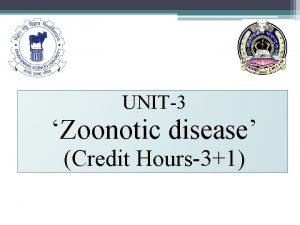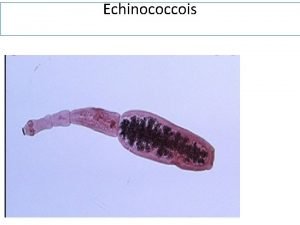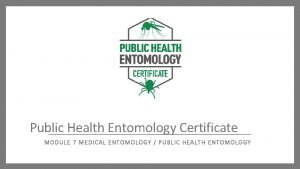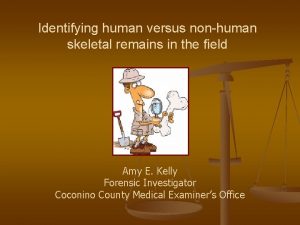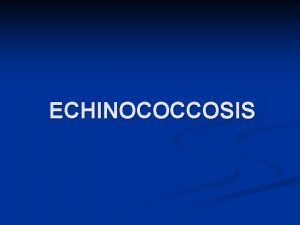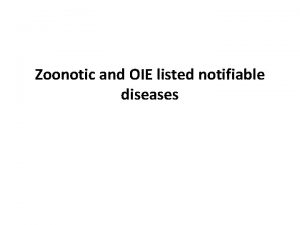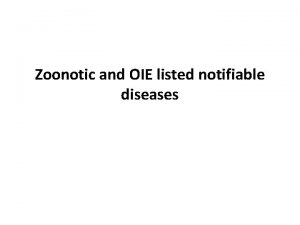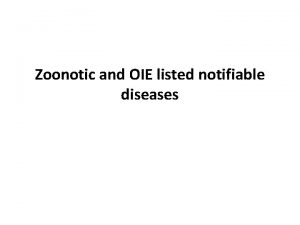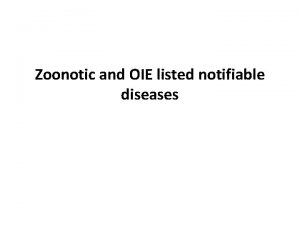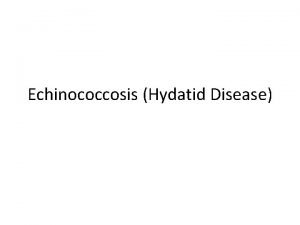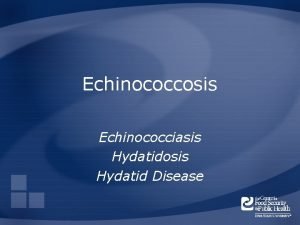Echinococcois Echinococcois Human echinococcosis is a zoonotic disease









- Slides: 9

Echinococcois

Echinococcois Human echinococcosis is a zoonotic disease (a disease that is transmitted to humans from animals) that is caused by parasites, namely tapeworms of the genus Echinococcus. Echinococcosis occurs in 4 forms: 1. cystic echinococcosis, also known as hydatid disease or hydatidosis, caused by infection with a species complex centred on Echinococcus granulosus. 2. Alveolar echinococcosis, caused by infection with E. multilocularis 3. two forms of neotropical echinococcosis: polycystic caused by infection with E. vogeli and 4. unicystic caused by E. oligarthrus.

Echinococcois: Transmission

Cystic echnicoccois • The parasite is transmitted to dogs when they ingest the organs of other animals that contain hydatid cysts. • The cysts develop into adult tapeworms in the dog. Infected dogs shed tapeworm eggs in their feces which contaminate the ground. Sheep, cattle, goats, and pigs ingest tapeworm eggs in the contaminated ground; once ingested, the eggs hatch and develop into cysts in the internal organs. • The most common mode of transmission to humans is by the accidental consumption of soil, water, or food that has been contaminated by the fecal matter of an infected dog. • Echinococcus eggs that have been deposited in soil can stay viable for up to a year. The disease is most commonly found in people involved in raising sheep, as a result of the sheep’s role as an intermediate host of the parasite and the presence of working dogs that are allowed to eat the offal of infected sheep.

Alveolar Echinococcosis • Alveolar echinococcosis (AE) is caused by infection with the larval stage of Echinococcus multilocularis. • AE is found across the globe and is especially prevalent in the northern latitudes of Europe, Asia, and North America. • The adult tapeworm is normally found in foxes, coyotes, and dogs. Infection with the larval stages is transmitted to people through ingestion of food or water contaminated with tapeworm eggs.

Diagnosis • The presence of a cyst-like mass in a person with a history of exposure to sheepdogs in an area where E. granulosus is endemic suggests a diagnosis of cystic echinococcosis. Imaging techniques, such as CT scans, ultrasonography, and MRIs, are used to detect cysts. After a cyst has been detected, serologic tests may be used to confirm the diagnosis. • Alveolar echinococcosis is typically found in older people. Imaging techniques such as CT scans are used to visually confirm the parasitic vesicles and cyst-like structures and serologic tests can confirm the parasitic infection.

Treatment • In the past, surgery was the only treatment for cystic echinococcal cysts. Chemotherapy, cyst puncture, and PAIR (percutaneous aspiration, injection of chemicals and reaspiration) have been used to replace surgery as effective treatments for cystic echinococcosis. However, surgery remains the most effective treatment to remove the cyst and can lead to a complete cure. Some cysts are not causing any symptoms and are inactive; those cysts often go away without any treatment. • The treatment of alveolar echinococcosis is more difficult than cystic echinococcosis and usually requires

Prevention & Control: Cystic Echinococcosis Cystic echinococcosis is controlled by preventing transmission of the parasite. Prevention measures include limiting the areas where dogs are allowed and preventing animals from consuming meat infected with cysts. • Prevent dogs from feeding on the carcasses of infected sheep. • Control stray dog populations. • Restrict home slaughter of sheep and other livestock. • Do not consume any food or water that may have been contaminated by fecal matter from dogs. • Wash your hands with soap and warm water after handling dogs, and before handling food. • Teach children the importance of washing hands to prevent infection.

Prevention & Control: Alveolar Echioncoccosis Alveolar echinococcosis can be prevented by avoiding contact with wild animals such as foxes, coyotes, and dogs and their fecal matter and by limiting the interactions between dogs and rodent populations. • Do not allow dogs to feed on rodents and other wild animals. • Avoid contact with wild animals such as foxes, coyotes and stray dogs. • Do not encourage wild animals to come close to your home or keep them as pets. • Wash your hands with soap and warm water after handling dogs or cats, and before handling food. • Teach children the importance of washing hands to prevent infection.
 Inscryption ringworm card
Inscryption ringworm card Zoonotic
Zoonotic Zoonotic diseases
Zoonotic diseases Communicable disease and non communicable disease
Communicable disease and non communicable disease The human body in health and disease chapter 2 answer key
The human body in health and disease chapter 2 answer key Arnold hilgers
Arnold hilgers The human body in health and disease chapter 2 answer key
The human body in health and disease chapter 2 answer key Chapter 2 the human body in health and disease
Chapter 2 the human body in health and disease Human vs non human bones
Human vs non human bones 8.3 human needs
8.3 human needs
